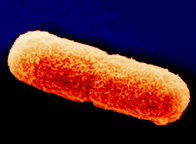
Photo taken by Richard Pau
Azotobacter vinelandii is a gamma-proteobacterium belonging to the family
Pseudomonadaceae. Over the years, A. vinelandii has served as a
model for biochemical analyses due to the extraordinary yield and
quality of enzymes that can be isolated from this organism. Most
recently these studies have been focused on the ability of
A. vinelandii to fix diatmospheric nitrogen using three distinct
nitrogenase systems under free-living conditions, a process that
occurs in the presence of oxygen levels that typically inactivate the
nitrogenase enzyme. A. vinelandii is also unusual in that, for
reasons that are not clear, it increases the copy number of its
chromosome up to 50-100 times during late log phase. In addition, it
provides an ideal system in which to investigate the processes of cyst
formation and xenobiotic degradation. Studies on these and other
aspects of Azotobacter biology will be significantly enhanced by the
provision of a finished and well-annotated genome sequence.
Within the Pseudomonadaceae family only one of the three main
genera has fully sequenced representatives (Pseudomonas). Provision of
the complete A. vinelandii genome therefore also serves as one of
the essential gold-standard phylogenetic anchor points for comparative
genomics.
